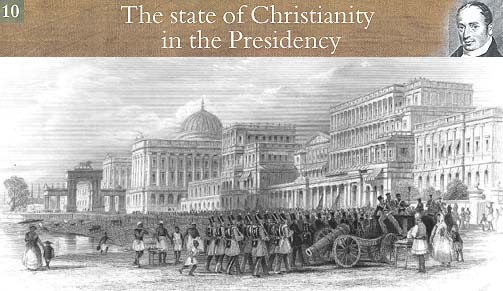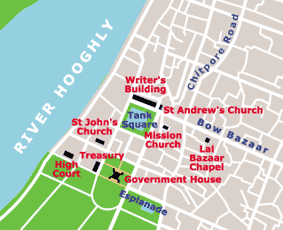

The Esplanade, Calcutta, in the middle of the 19th century. Government House, built by Lord Wellesley, is the building with the dome behind the ceremonial gateway. Courtesy 'The Centre for the Study of the Life and Work of William Carey D.D., 1761 - 1834.' John Clark Marshman describes the state of Christianity in India as being at the 'lowest ebb', and the condition of the clerical department under the Church of England as 'deplorable'. The number of chaplains in Calcutta was no more than during the early days of the settlement. Divine service was only performed in the morning in one church, and in the evening in another. No services were held at all in the interior of the country. Military chaplains formerly had the rank of Major, but they had now been demoted to Captains. There were 5 military chaplains for the whole country, and some of them were unworthy of their profession. Salaries were so small, and their status so unattractive, that few men of learning could be attracted to fill the positions. Chaplaincies were given away by India House, in London, as favours, without any regard for the merits of the candidates. A description of 2 of the chaplains by a member of their own body illustrates the situation.
'Mr. --- is avaricious in the extreme, and pockets more than half the allowance of his clerk. Mr. --- , just arrived, came out professedly to get bread for his children. I knew one clergyman on our establishment who had neither Bible nor Prayer-book.' Mr. --- ought absolutely to be turned out of the service in the same manner as a dishonest civilian, or a cowardly soldier; and Mr. --- is deranged, he should be deported home, that another may be appointed in his place.'
At the beginning of the 18th century, soon after the establishment of a factory at Calcutta, one of the first buildings to be erected was a church. It was consecrated in 1709 and was described as a splendid edifice. The steeple was regarded as a great ornament to the settlement but it was brought down by an earthquake in 1737. (1)
During the sack of Calcutta by Siraj-ud-Daula in 1756 (which included the notorious incident, which, ever since has been known as 'The Black Hole of Calcutta') the church was raised to the ground. When the British recaptured Calcutta, a sum was paid by the Nabob in Murshidabad, in 1757, in reparation for the destruction of the church. The money was set aside but no action was taken. Fort William was substantially enlarged and rebuilt further south, with a free fire zone all around, which still survives as the Maidan, but the Court of Directors decreed that no church should be built until accommodation for servants, barracks for soldiers, and every other building of consequence were completed. Despite amassing fortunes, the British community made no effort to rebuild the church; the Governor, the Governor-General, the Members of Council, the royal judges, the barristers and the merchants of renown, were content to meet for divine worship in a room adjoining the 'Black Hole'.
The new church of St John's was not completed until 1786. It had been funded by lotteries, confiscations and donations received contrary to law. The land was donated by a Hindu. It became the state church, with official chairs for the Governor-General and his suite, and velvet covered chairs for the judges and Members of Council.
The Mission Church, (2) founded by Kiernander for his Portuguese and Indian congregations, came into the hands of Mr. Grant in 1786 - the same year that saw the opening of St. John's. Under Mr. Brown's ministry the congregation was no longer stigmatised as a place for 'stable boys and paupers'. The building was trebled in size and the old congregation melted away before the influx of gentry from the highest and middling classes. The humbler class had nowhere to go on a Sunday except the liquor shops.

Calcutta in the 19th century. Detail based on a French made map courtesy 'The Centre for the Study of the Life and Work of William Carey D.D., 1761 - 1834'. For the full map click here The Lal Bazaar Chapel The Serampore missionaries had previously rented a room, at their own expense, in January 1803, but their success was only partial. Many objected to entering the home of a private individual for public worship. The room was poorly chosen because it was a large hall in the house of Mr. Lindeman, the undertaker. It was therefore evident that a public edifice was necessary.
The undertaking was frequently discussed with Mr. Brown at 'Aldeen', Serampore. He encouraged the missionaries, and contributed financially towards the project.
William Ward drew up the prospectus of the building, and on 1st January, 1804, attended a meeting of the friends of the cause in Calcutta. The objective of the senior missionaries was not to set up a chapel for their own denomination, but to provide religious instruction for those who were served by no other church. The building would be open to all denominations. At the meeting, £380 was subscribed on the spot, £100 was provided by the Serampore missionaries, and in the course of the year the fund rose to £700. The expense of completing the building eventually fell on the missionaries themselves, who were obliged to advance more than half the builder's costs from their own resources, and thus the chapel came under their control.
In March, 1806, the grounds for the chapel were purchased at a cost of 7,250 rupees. The site was situated in Bow Bazaar, a street that ran east from the north-east corner of Tank Square. The square contained a large tank (or lake) which was the site of the original Fort William, the Writer's Building, the Court House, hotels, and, to the south, Government House. At the time, Bow Bazaar was a hotbed of vice and immorality and was also the Tyburn of Calcutta where hangings took place. There was an awful spot called Gullakutta Gully, or throat-cutters' lane. (3) It was surrounded by liquor shops and brothels which were the haunt of sailors. The site itself was being used as a brothel. The buildings were immediately cleared away and a neat thatched bungalow was erected in the centre of the site.
Ward preached the first sermon there on 1st June 1806. It was the first time the Gospel had been preached to the inhabitants of Calcutta in their own language, and in public. Crowds poured in at the gate and filled the bungalow and compound to listen to a Christian discourse from the lips of Hindu converts, and to see a European gentlemen addressing the people. As the preachers walked through the streets they were followed by crowds who clapped their hands and poured abuse on them. When Ward made his appearance (he spoke the colloquial language with singular ease and purity) the people shouted "That's he; that's the Hindoo padre; why dost thou destroy the caste of the people."
On the third Sunday, the appearance of Rammahun, a converted Brahmin, who exhorted his fellow countrymen to embrace a foreign religion, created an even greater sensation. He was overwhelmed by the vituperation and withdrew. One man came up to him and and said "O vagabond! why didst thou not come to my house; I would have given thee a handful of rice rather than thou shouldst have become a feringee."
Amidst all this excitement there was no tumult and no disturbance. The interest that was created filled the missionaries with delight.
Sunday, 24th August, 1806, is described in Ward's journal as a 'memorable' day in Calcutta. At 10am in the morning he preached to a large and attentive audience in Bow Bazaar, as the earlier excitement had subsided. At 1pm he went to the Chitpore Road where some Armenians had opened a house for services in Bengali, which they understood better than English. The room, the compound, and the street were crowded. After preaching with great animation he returned to Bow Bazaar and preached to another congregation. On leaving his Armenian and other friends he remarked that this Sabbath was one of the happiest days of his life, and that he hoped he would spend many such in Calcutta. Little did he know this was to be the last occasion for a considerable time as the opposition of Government had already begun.
The plans for the new chapel had been drawn up, and by February, 1807, building work was well in hand. The walls were rising rapidly when Mr. Blacquiere, one of the magistrates of Calcutta, who kept an eye on the activities of the missionaries, informed the architect that as it was a public building and it needed authority from the Government for its erection. Carey and his colleagues considered an application to the Governor-General in their own names but were deterred when advised that permission would not be granted. The architect was instructed to continue with his work. Within a fortnight Mr. Blacquiere sent for the architect a second time and threatened to make an immediate report to Government unless permission was obtained to erect it. It was suggested to the missionaries that permission would more likely be obtained if a request was made by the Christian community of Calcutta for a Protestant place of worship. A memorial to the Governor-General was drawn up by Joshua Marshman. During April he visited the principal inhabitants of Calcutta not in the public service, and obtained more than 100 signatures to it. To the great delight and surprise of the missionaries permission was granted within a week for construction to proceed.
The erection of the chapel was pushed on with great vigour, but it soon reached a stage where the architect, Mr Rolt, was owed a considerable amount. Marshman raised subscriptions by visiting the most opulent residents of Calcutta. He was generally received with courtesy, and in less than 10 days had raised £1,100.
(1) For a 1730 painting of St. Anne's Church click on the link.
(2) For a 1786 engraving of the Old Mission Church click on the link.
(3) 'Calcutta', Geoffrey Moorhouse, Weidenfeld and Nicholson, 1971.